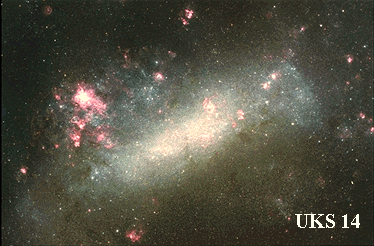Credit & Copyright: Anglo-Australian Telescope
Board
Explanation:
Magellan and his crew had plenty of time
to study the southern sky
during their famous voyage around the world. As a result, two fuzzy
cloud like objects, nestled among the southern constellations of Doradus
and Tucana are now
known as the Clouds of Magellan. The Magellanic Clouds are small irregular
galaxies, satellites of our
larger Milky Way spiral galaxy.
The Large Magellanic Cloud
(LMC) pictured above is the closest galaxy to our own Milky Way,
at a distance of about 180,000 light years.
The Magellanic Clouds are joined to the Milky Way by a
stream of cold hydrogen gas whose origin is still controversial.
An unusual effect called
gravitational lensing has recently
been detected in a few LMC stars, and there is hope this could
tell us important information about the
true composition of our universe.
1999 2000 2001 2002 2003 2004 2005 2006 2007 2008 2009 2010 2011 2012 2013 2014 2015 2016 2017 2018 2019 2020 2021 2022 2023 2024 2025 |
Yanvar' Fevral' Mart Aprel' Mai Iyun' Iyul' Avgust Sentyabr' Oktyabr' Noyabr' Dekabr' |
NASA Web Site Statements, Warnings, and Disclaimers
NASA Official: Jay Norris. Specific rights apply.
A service of: LHEA at NASA / GSFC
& Michigan Tech. U.
|
Publikacii s klyuchevymi slovami:
Magellanovy Oblaka - Bol'shoe Magellanovo Oblako - Nepravil'naya galaktika - gravitacionnoe linzirovanie
Publikacii so slovami: Magellanovy Oblaka - Bol'shoe Magellanovo Oblako - Nepravil'naya galaktika - gravitacionnoe linzirovanie | |
Sm. takzhe:
Vse publikacii na tu zhe temu >> | |
